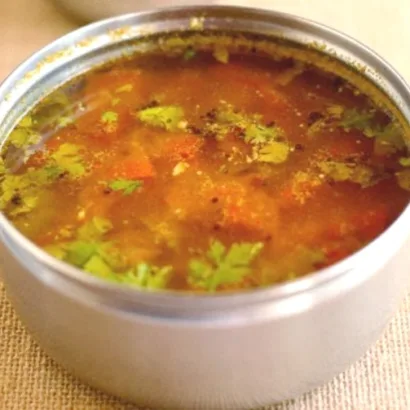
Rasam
Rasam, a cherished South Indian soup, is a symphony of flavors that dances on the taste buds, leaving a trail of warmth and comfort. This aromatic and tangy concoction is more than just a dish—it's a cultural heritage, a comfort food, and a remedy that has been passed down through generations.
Ingredients
- 1 medium-sized tomato, chopped
- 1/4 cup tamarind pulp (soak tamarind in warm water and extract pulp)
- 1/2 cup cooked and mashed toor dal (split pigeon peas)
- 1 teaspoon rasampowder (modify according to your preference)
- 1/2 teaspoon turmeric powder
- 1 teaspoon black pepper
- 1 teaspoon cumin seeds
- 2-3 garlic cloves, crushed
- 1 tbsp ghee or oil
- 1/2 teaspoon mustard seeds
- A pinch of asafoetida (hing)
- Curry leaves
- Fresh coriander leaves for garnish
- Salt to taste
Instructions
- In a pot, add the chopped tomato, tamarind pulp, turmeric powder, rasampowder, and salt. Let it simmer on medium heat until the tomatoes soften and the mixture thickens slightly.
- While the mixture is simmering, grind the black pepper and cumin seeds to a coarse powder using a mortar and pestle. Add this powder to the pot.
- Add the cooked and mashed toor dal to the mixture. Mix well to combineall the ingredients.
- In a small pan, heat ghee or oil. Add mustard seeds and let themsplutter. Add crushed garlic, asafoetida, and curry leaves. Sauté for a fewseconds until aromatic.
- Pour the tempering into the rasam mixture and stir well. Allow the rasam to simmer for another 5-7 minutes, allowing the flavors to meld.
- Taste and adjust the seasoning if needed. If the rasam is too thick, youcan add some water to achieve the desired consistency.
- Garnish with fresh coriander leaves just before serving.
Notes
- Feel free to adjust the level of spiciness by varying the amount of black pepper and rasam powder.
- Traditional rasam powder includes a blend of spices like coriander seeds, red chili, cumin, fenugreek, and more. You can use store-bought rasam powder or make your own.
- The tamarind pulp provides the tangy flavor that is characteristic of rasam. Adjust the amount of tamarind to your taste preference.
- You can serve rasam as a soup or as a complement to steamed rice, along with a variety of side dishes.
- Rasam is known for its soothing properties, making it a great choice when you're feeling under the weather or need comfort food.
- Remember to adjust the salt carefully, as the tamarind pulp and rasam powder may already contain some salt.